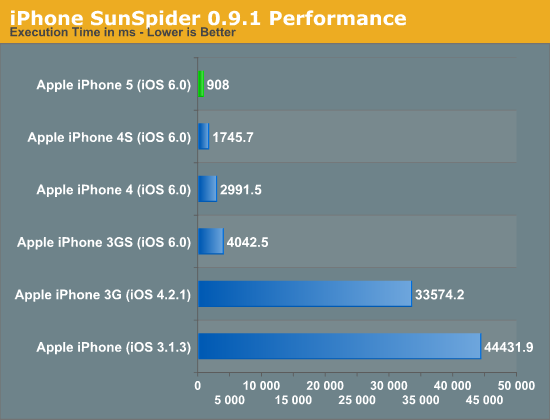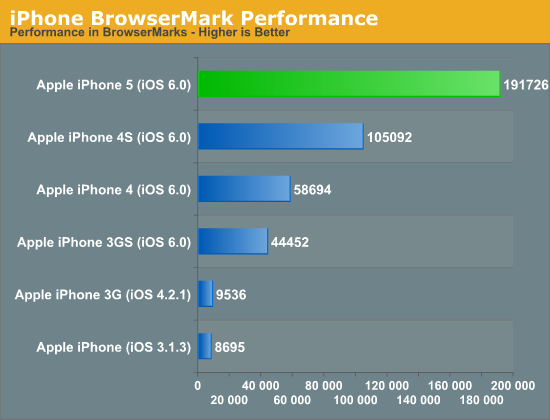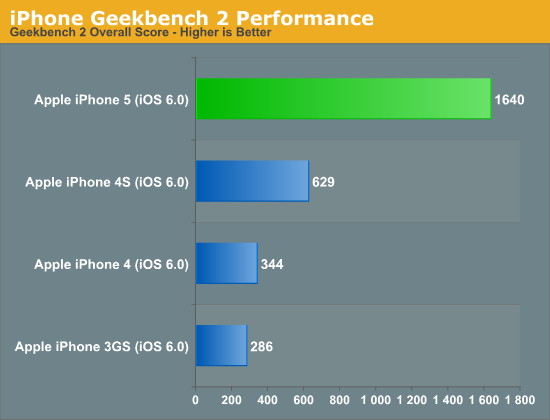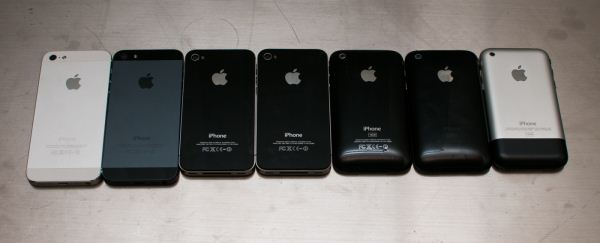The iPhone 5 Review
by Anand Lal Shimpi, Brian Klug & Vivek Gowri on October 16, 2012 11:33 AM EST- Posted in
- Smartphones
- Apple
- Mobile
- iPhone 5
Six Generations of iPhones: Performance Compared
Section by Anand Shimpi
Cross platform smartphone benchmarks are interesting, but they do come with their own sets of issues. Before we get to that analysis however, let's look at how the iPhone's performance has improved over the past six generations. Luckily Brian has a set of all of the iPhones so he was able to run a few tests on all of the devices, each running the latest supported OS.
We'll start with SunSpider 0.9.1, our trusty javascript performance test:

The transition from iPhone to iPhone 3G shows you just how much additional performance you can squeeze out of simply a software change. There's likely even more that could be squeezed out of that ARM11 platform, unfortunately newer versions of Safari/iOS aren't supported on the iPhone 3G so we're left with a runtime that's around 37x the length of a single run on the iPhone 5.
The rest of the devices support and run iOS 6, so we're at least on a level software playing field. The performance boost from one generation to the next is quite significant still. Going by this chart alone, the best balance of minimal upgrades and maximum perceived improvement would be from the original iPhone to the 3GS then again from the 3GS to the 5.

The BrowserMark results tell a similar story. The jump from the ARM11 based iPhone/iPhone 3G to the 3GS running iOS 6 is huge. Both the 4S and 5 offer doublings in performance, albeit for different reasons. The 4S delivered a doubling thanks to a doubling of core count and a move to the Cortex A9, while the iPhone 5 doubled performance through a much higher clock speed and microarchitectural improvements.
Finally we have Geekbench 2, which only runs on the iOS 6 supported devices so we say goodbye to the original iPhone and iPhone 3G:

None of the jumps looks as dramatic as the move to the iPhone 5, but we already know why. The Swift CPU architecture does a great job improving memory performance, which shows up quite nicely in a lot of the Geekbench 2 subtests.
On the PC side we often talk about 20% performance improvements from one generation to the next being significant. It's clear that the mobile SoC space is still operating along a hyper Moore's Law curve. The rate of progress will eventually slow down, but I don't see that happening for at least another couple generations. The move to ARM's Cortex A15 will be met with another increase in performance (and a similarly large set of power challenges), and whatever comes next will push smartphones into a completely new category of performance.












276 Comments
View All Comments
ArmedandDangerous - Tuesday, October 16, 2012 - link
What ever happened to the One X International review that was promised when you were reviewing the US version? Lots of promised articles and reviews that were never ever done...MrCake - Wednesday, October 17, 2012 - link
Yeah, already posted this comment for podcast 8, but it bears repeating. I'm less angry now, but still facepalming.It's not my expertise but I have designed a few hundred aluminum parts, so here's how it probably
works. The call-out is most likely equivalent to mil-std-171 7.2.2; this is a ~.0005" thickness coat,
decorative and scratch resistant. The coating itself is super hard, and can only be scratched by harder materials. The problem is the base metal yield strength is still fairly low. Chamfers (yes, we do pronounce the "h") have sharp edges, which make point contacts and therefore have theoretically infinite contact stresses till they're rounded off. To summarize; small contact areas, equal high pressures even at low forces; pressures over material yield cause deformations, and deformations over .0005" make you see silver. The chamfer finish is probably not a post anodization process,it's diamond ground and has a much finer surface finish. The rest of the phone is cnc milled, and is matte from either a sandblasting, or vibratory media process to remove machining marks. Anodize surfaces are as glossy/matte as their surface finish. And as to the "structural integrity" concern repeated, and repeated, and repeated; The iphone is thin, but the anodize coating is a couple orders of magnitude thinner and has negligible affect on structural integrity.
A possible fix would be mil-std-171 7.5.2 Anodize Type III which is an anodized hardcoat. It's a
similar process but coats to .002" thick, packs it's molecules much denser, and can pass a hardness test to rockwell C60. It's a reasonable response to the scratching issue, however it may not be appropriate for other reasons(prone to cracking instead of scratching, tolerance issues, more costly, less pretty.)
syxbit - Wednesday, October 17, 2012 - link
Great job guys. I'd appreciate it if you went into as much detail on the upcoming Nexus device(s).KPOM - Wednesday, October 17, 2012 - link
They will.WooDaddy - Wednesday, October 17, 2012 - link
I didn't RTFA (as if I need to question Anand consistently excellent analysis as it has been Anandtech's inception), but as soon as I saw the phrase 'murdered out' regarding the black/slate color, I was done. It was like Anand was at a poetry slam and he dropped the mic signifying that there is no one better.VivekGowri - Wednesday, October 17, 2012 - link
Hey, hey, I wrote that part :Pjuhatus - Wednesday, October 17, 2012 - link
iPhone review.. what about..Does it work as a phone??
SJD - Wednesday, October 17, 2012 - link
Don't know if I'm the first one to say this, but the HTC One S battery isn't removable. (At least it isn't over here in the UK - don't know if your version in the US is any different).Table - Physical Comparison - Page 1
Origin64 - Wednesday, October 17, 2012 - link
I do really want to point out that the iPhone 5 being 20% lighter than the 4 isn't really substantial, seeing as how a Galaxy S 1 weighs about half of that.Apple has excellent construction quality, but they build their phones from glass and aluminium and they are heavier than the competition. There's no advantage here, no breakthrough, the iPhone 5 is just a different design that has a thinner battery and less glass. It's not as interesting as you make it seem.
thunng8 - Wednesday, October 17, 2012 - link
What are you on about? The Galaxy S weighs 119g and the iphone 5 weighs 112g.